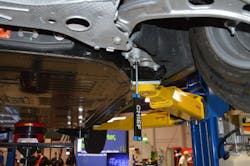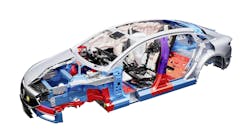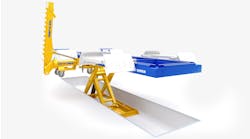Content brought to you by ABRN. To subscribe, click here.
What you will learn:
- How structure impacts EV repair
- The proper process to blueprinting
- The dangers of EV batteries
In today’s world, electric vehicles are a hot topic among consumers. In recent years, manufacturers have joined the conversation and shared how they plan on contributing to the future of EV production. In 2021, General Motors announced it would dedicate more than half of its capital budget and product development team to “electric and electric-autonomous vehicle programs,” noting that in the coming years, consumers can expect this American-based brand to offer an array of electric crossovers, SUVs, trucks and sedans.
Now that more companies are doubling down on their commitment to producing quality and affordable EVs, the way we go about structural repair will change.
Feel behind on everything that is EVs? Let’s discuss the repair process, EV risks and shop considerations, to get you started.
How structure impacts repair
Remember what it was like to repair a vehicle 20 or 30 years ago? The structure of vehicles gave no grace when in an accident. Vehicles truly showed the impact given – and sometimes, even worse than the accident that occurred. Today’s vehicles, however, show a different face in our shop. New advancements and protective barriers have worked to change how the power of impact is distributed throughout the vehicle.
EVs can weigh more than their internal combustion engine counterparts. Additions such as bracing, reinforced framework and suspension, the battery, and the metal armor to protect it have served to not only protect the passengers, but the vehicle’s battery too.
So, what does this have to do with collision repair? With EVs becoming even more popular amongst consumers, repair shops are left wondering how its structural makeup will change the current flow of a shop’s repair process. Luckily, we have the solution: Blueprinting.
Blueprinting does more than just plan your overall repair process. It eliminates inefficiencies and guides your team in making repairs as accurately as possible. It also helps you create a continuous workflow in your shop, which leads to greater productivity, profitability, and customer satisfaction. A proper blueprinting process will help you address EVs as they come and guide you to creating the best plan moving forward. Here’s how to do it in four simple steps:
1. Use collision dynamics to evaluate damage during a visual inspection
Collision dynamics explain the relationship of forces involved in a collision to the damage created by those forces. Understanding this relationship provides understanding into where the damage may have occurred that’s not obvious at first glance. For instance, lateral and vertical deflections can cause indirect damage that could go unnoticed without applying collision dynamics – especially when you’re looking at an EV.
2. Measure the vehicle to reveal hidden damage
Structural damage doesn’t necessarily reveal itself so easily, so it’s important to have a system that works with you to find damages not seen by the naked eye. One is our Meridian Live Mapping System with the Galileo Scanner. This scanner allows you to precisely measure and pull information to provide the most comprehensive and up-to-date vehicle data available. Furthermore, this blueprinting system uses a precise single-hub laser to provide a quick and accurate 360-degree view of damage not visible to the naked eye. The scanner footprint gives you the flexibility to target line of site, so that more measurements can be taken and an accurate detail of damage can be documented for your technicians.
3. List all parts, materials, and operations required to repair the vehicle
Now that our damages – both visible and invisible – have been identified, it’s time to list out what’s needed for a successful repair. Without a formal checklist, it’s easy to miss a crucial part or skip a step in the process. These errors lead to prolonged or inaccurate repairs, decreasing your productivity and profitability.
4. Write out your repair plan
By identifying the damages in need of repair and gathering a thorough checklist of the required materials, it’s easy to begin sequencing the steps your techs will need to make a full repair, and when you know what each vehicle in your shop needs – both EV and non-EV – it’s easy to maximize your workflow.
The dangers of EV batteries
Although the batteries used in EVs are durable and can take a beating with little to no damage, there are several safety considerations that should be addressed before you begin repairs. We know that accidents are inevitable, but please note that accidents involving EVs are less merciful due to its ability to retain high voltages. Make sure your team is careful and ensures all safety measures while addressing EVs. Simply put, don’t cut corners.
During your initial vehicle inspection, check the EV’s plug in and search for high voltage cables that may be exposed or damaged. If there is damage – or you assume there is damage to any of these areas – it’s time to bring in a high voltage expert to assess the risk and ensure the safety of your technicians. Especially when we consider the dangers of an EV charged fire.
A normal vehicle fire can reach dangerous temperatures of 1,500 degrees F, but the material that makes up an EV’s battery can burn at more than 3,000 degrees F. These life-threatening fires are more difficult to extinguish than you may realize.
The National Transportation Safety Board continues to report incidents where an EV’s battery reignited even after first responders extinguished the fire. In one report, first responders arrived at the scene of an active fire regarding a completely demolished EV. Once the fire was extinguished, the team worked to load the vehicle on a truck and transport it to a nearby collision center. During that transfer, the battery shifted and new short circuits were created – causing the fire to restart.
Another case stated that in Mountain View, Calif, an EV that had caught fire was extinguished onsite and was successfully brought to a shop for repair. Even though the fire was fully extinguished, the battery still retained some of its energy, and the vehicle reignited five days later after business hours. Responders were called immediately to the scene.
With that, it’s important to consider what may be surrounding an EV in your shop. We recommend that ample space be given in the instance a fire is to occur. If you are unable to do so, consider removing the vehicle from your shop and take it outside. A high voltage expert can help you assess additional risk and provide thorough recommendations on how to keep your shop safe.
An additional safety measure that your shop can implement is having clear and visible signage addressing the state of the EV at all times. This lets those know when the vehicle is safe to approach, when to be cautious and when it is not safe and should be avoided by all.
Additional considerations
In the Aug./Sept. Issue, I broke down how to best prepare your shop for ADAS for the next generation of vehicles. What we didn’t touch on is what this means from a customer service standpoint – specifically for EVs. After the repairs are finished, we know that a positive customer experience involves sending the vehicle to detailing and filling it with gas before we hand the keys over… one that can’t happen in an EV. So, if your shop is servicing EVs, then it’s time to invest in an EV charger.
There are several charger options available on the market. If your shop values efficiency and getting projects completed faster, there are three things to consider when purchasing an EV charger;
- Not all fast-acting chargers work the same. There are high amounts of energy being transmitted in fast acting chargers, so it’s essential that it has cooling capabilities. Cheaper models may not include this, so check before you buy.
- Different chargers have minimum power requirements. Be sure to check your shop’s power capabilities before purchasing. It’s important that you get the full value of what the charger can offer. Otherwise, you should consider a lower tiered charger.
- How does your shop determine the number of charging stations to purchase? The simple solution is to evaluate your shop’s EV inventory on a weekly or monthly basis. Make a decision that best supports your shop. If the numbers aren’t there but you’re looking to add more ROI, consider installing a card swiper and open your chargers to the public. Not only does this generate more revenue, but it also shows that your shop is equipped to service EVs.
We know that the future of transportation is electric, and as a global leader in the collision repair space, our team of experts work diligently to keep you up to date on industry trends and provide hi-tech solutions that keep today’s modern day body shops repairing smarter, not harder.





